
Traditional training methods are becoming obsolete as virtual reality transforms how we learn, practice, and develop professional skills. Research consistently shows that VR training delivers superior results across every metric that matters—from knowledge retention to skill acquisition speed.
The evidence is overwhelming: employees trained in virtual environments retain 75% of information after one year, compared to just 10% from lecture-based training. This isn’t just incremental improvement—it’s a fundamental shift in how effective learning happens.
This comprehensive guide explores the research-backed benefits of VR training, examining why forward-thinking organisations are making the switch and how you can leverage this technology to revolutionise your professional development programmes.
The Science Behind VR Training Success
Virtual reality training works because it engages multiple learning systems simultaneously. Unlike traditional methods that rely primarily on auditory or visual channels, VR creates immersive experiences that activate spatial memory, emotional engagement, and motor learning pathways together.
How VR Enhances Memory Formation
When learners navigate virtual environments and interact with three-dimensional objects, their brains create stronger neural pathways than traditional training methods can achieve. This spatial memory advantage explains why VR training remains effective long after initial completion.
The phenomenon occurs because VR activates the same brain regions involved in real-world experiences. A study published in the Journal of Medical Internet Research found that medical students trained using VR surgical simulators retained procedural knowledge 40% longer than those trained through traditional methods.
This memory enhancement stems from VR’s ability to create what researchers call “embodied learning”—experiences that feel real enough to trigger the same cognitive processes as actual practice.
The Role of Emotional Engagement
VR training succeeds because it creates emotional connections to learning content. When trainees feel genuinely present in virtual scenarios, they develop stronger emotional memories that improve long-term retention.
Research demonstrates that learners who experience emotional engagement during training sessions score 23% higher on retention tests compared to those who receive purely informational instruction. VR naturally creates this emotional engagement through immersive storytelling and realistic scenarios.
Accelerated Learning Through Virtual Practice
One of VR training’s most significant advantages is its ability to compress learning timelines without sacrificing quality. Automotive manufacturers report 40% faster training completion rates when using VR compared to traditional methods.
Unlimited Practice Opportunities
Virtual environments eliminate the logistical constraints that slow conventional training. Learners can practice procedures repeatedly without waiting for equipment availability, instructor schedules, or physical resources.
This repetition advantage proves particularly valuable for complex technical skills that require extensive practice. Manufacturing companies document substantial time savings through VR implementation, with workers learning equipment maintenance procedures 30% faster in virtual environments.
The ability to make mistakes and learn from them accelerates the learning curve significantly. Trainees can attempt procedures multiple times in quick succession, rapidly building muscle memory and confidence without real-world consequences.
Personalised Learning Pathways
VR technology enables unprecedented personalisation in training programmes, adapting to individual learning styles and paces. Research indicates that personalised VR training improves learning outcomes by 30% compared to standardised approaches.
Adaptive VR systems monitor learner performance and adjust difficulty levels automatically. Struggling learners receive additional practice opportunities and simplified explanations, whilst advanced learners face more challenging scenarios.
Healthcare training programmes demonstrate personalisation benefits through customised surgical simulations. Medical residents practice procedures tailored to their experience levels, progressing through increasingly complex scenarios as their skills develop.
Risk-Free Training Environments
VR’s ability to provide safe training environments for dangerous or high-stakes procedures represents a revolutionary advantage. This safety benefit extends beyond physical protection to psychological comfort, creating optimal learning conditions.
High-Risk Scenario Training
Aviation training research shows that pilots trained in VR environments demonstrate superior performance during actual emergency procedures. The virtual practice allows pilots to experience and respond to crisis situations without risking lives or expensive equipment.
Chemical industry training programmes utilise VR to teach hazardous material handling procedures. Workers can experience the consequences of improper handling in virtual environments, learning critical safety protocols without exposure to dangerous substances. This approach reduces workplace accidents by 50% compared to traditional safety training methods.
Building Confidence Through Repetition
The psychological safety of virtual environments allows learners to practice challenging scenarios repeatedly until they achieve mastery. This repetition builds confidence that translates directly to real-world performance.
Emergency response training exemplifies this benefit. Firefighters, police officers, and medical personnel can practice high-stress scenarios in virtual environments, developing the muscle memory and decision-making skills needed for actual emergencies.
Measurable ROI and Cost Benefits
Beyond learning effectiveness, VR training delivers measurable financial benefits that justify implementation costs. Organisations report significant returns on investment through reduced training time, improved safety outcomes, and enhanced skill retention.
Reduced Training Costs
VR training eliminates many traditional training expenses, including travel costs, facility rentals, equipment wear, and instructor fees. Companies can train multiple employees simultaneously in virtual environments without duplicating physical resources.
Retail chains report 60% reduction in training costs after implementing VR programmes for customer service and product knowledge training. The technology enables consistent, high-quality training across all locations without requiring expert trainers at each site.
Improved Safety Outcomes
The safety benefits of VR training translate directly to reduced insurance costs and liability exposure. Companies implementing VR safety training report 35% fewer workplace accidents and 45% reduction in safety-related incidents.
These improvements occur because VR allows workers to experience realistic safety scenarios without actual danger. The memorable nature of virtual experiences creates stronger safety awareness than traditional classroom instruction.
Enhanced Performance Metrics
VR-trained employees consistently outperform their traditionally-trained counterparts across multiple performance indicators. Customer service representatives trained in VR demonstrate 25% higher customer satisfaction scores and 20% faster problem resolution times.
The immersive nature of VR training creates muscle memory and automatic responses that improve job performance. This enhanced performance leads to better business outcomes and competitive advantages.
Industry-Specific Applications
Different industries leverage VR training in unique ways, tailoring virtual environments to specific professional requirements and challenges.
Healthcare and Medical Training
Medical education represents one of VR training’s most successful applications. Surgical residents can practice complex procedures repeatedly without patient risk, building skills and confidence before entering operating rooms.
Nursing programmes use VR to simulate patient interactions and medical emergencies. Students practice clinical decision-making in realistic scenarios, developing critical thinking skills that improve patient outcomes.
The technology also supports continuing medical education, allowing practising physicians to stay current with new procedures and techniques through immersive virtual experiences.
Manufacturing and Industrial Training
Manufacturing companies use VR to train workers on complex machinery and assembly processes. The technology enables safe practice with expensive equipment whilst providing immediate feedback on technique and efficiency.
Quality control training benefits significantly from VR implementation. Workers can practice identifying defects and understanding quality standards in virtual environments before working with actual products.
Safety training programmes in manufacturing use VR to simulate hazardous conditions and emergency procedures. Workers experience realistic scenarios without exposure to actual dangers, building critical safety skills.
Sales and Customer Service Training
VR transforms sales training by creating realistic customer interaction scenarios. Sales representatives can practice handling objections, presenting products, and closing deals in immersive virtual environments.
Customer service training uses VR to simulate difficult customer interactions and complex problem-solving scenarios. Representatives develop communication skills and emotional intelligence through repeated practice with virtual customers.
The technology also enables cultural sensitivity training, helping employees understand and respond appropriately to diverse customer needs and communication styles.
Overcoming Implementation Challenges
Despite VR’s proven benefits, organisations face several challenges when implementing these technologies. Understanding and addressing these obstacles is crucial for successful VR adoption.
Technical Infrastructure Requirements
VR systems demand robust technical infrastructure to deliver optimal experiences. Network latency, processing power, and graphics capabilities must meet stringent requirements to prevent motion sickness and maintain immersion.
Cloud-based VR solutions are emerging as alternatives that reduce hardware requirements whilst providing access to high-quality experiences. These platforms distribute processing demands across remote servers, enabling VR access from less powerful local devices.
User Acceptance and Change Management
Employee acceptance represents a critical success factor in VR implementation. Many workers may be unfamiliar with VR technology or hesitant to embrace new learning methods.
Successful implementations begin with pilot programmes that demonstrate VR’s benefits to early adopters. These champions then become advocates who encourage broader adoption throughout the organisation.
Training programmes must address technology anxiety and provide support for users who struggle with VR interfaces. Gradual implementation with adequate support ensures positive user experiences that drive adoption.
Content Development and Maintenance
Creating high-quality VR training content requires specialised skills and ongoing maintenance. Organisations must invest in content development capabilities or partner with experienced VR training providers.
The most successful implementations combine off-the-shelf VR training solutions with custom content tailored to specific organisational needs. This approach balances cost-effectiveness with customisation requirements.
Future Trends in VR Training
The VR training landscape continues evolving rapidly, with emerging technologies promising even greater benefits and accessibility.
Artificial Intelligence Integration
AI-powered VR training systems will provide increasingly sophisticated personalisation and adaptive learning experiences. These systems will analyse learner behaviour in real-time, adjusting scenarios and difficulty levels to optimise learning outcomes.
Natural language processing will enable conversational interactions with virtual characters, creating more realistic and engaging training scenarios.
Extended Reality (XR) Solutions
Mixed reality and augmented reality technologies will complement VR training, creating comprehensive extended reality learning environments. These hybrid approaches will combine virtual scenarios with real-world practice opportunities.
Mobile VR Accessibility
Advances in mobile VR technology will make training more accessible and cost-effective. Smartphone-based VR solutions will enable training deployment without significant hardware investments.
Implementing VR Training Successfully
Successful VR training implementation requires careful planning, stakeholder buy-in, and phased deployment strategies.
Assessment and Planning
Begin with thorough assessment of current training needs and identification of scenarios where VR will provide the greatest benefit. Focus on high-risk, high-cost, or frequently repeated training requirements.
Develop clear success metrics and measurement strategies to demonstrate ROI and guide programme optimization. These metrics should include both learning outcomes and business impact measures.
Pilot Programme Development
Start with small-scale pilot programmes that demonstrate VR’s benefits and identify implementation challenges. Choose scenarios with clear success criteria and enthusiastic participants.
Use pilot results to refine implementation strategies and build organisational support for broader deployment.
Scaling and Optimisation
Successful pilots should be scaled gradually, incorporating lessons learned and user feedback. Develop internal expertise and support systems to ensure sustainable implementation.
Continuous monitoring and optimisation ensure that VR training programmes deliver ongoing value and adapt to changing organisational needs.
Transforming Professional Development Through Virtual Reality
VR training represents more than technological advancement—it’s a fundamental shift toward more effective, efficient, and engaging professional development. The research is clear: organisations that embrace VR training gain significant competitive advantages through improved learning outcomes, reduced costs, and enhanced safety.
The question isn’t whether VR training will become mainstream, but how quickly your organisation can leverage its benefits. Early adopters are already seeing remarkable results, whilst competitors relying on traditional methods fall behind.

I am Ray Jones Digital
My current occupations: a Digital Marketer, Local SEO expert, Link Builder, and WordPress SEO specialist. Shopify SEO, Ecommerce Store Management, and HTML & WordPress Developer I have been practicing the above mentioned services for more than 10 years now As an SEO expert working with your ongoing projects.



